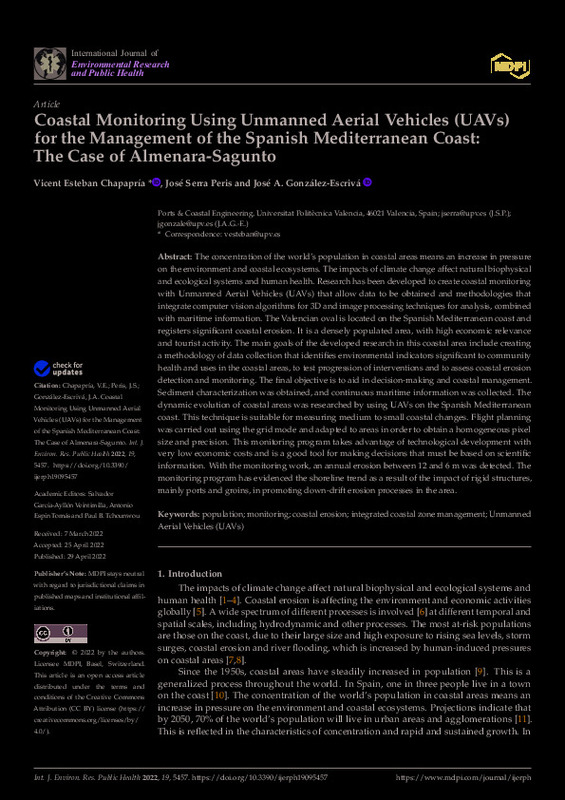JavaScript is disabled for your browser. Some features of this site may not work without it.
Buscar en RiuNet
Listar
Mi cuenta
Estadísticas
Ayuda RiuNet
Admin. UPV
Coastal Monitoring Using Unmanned Aerial Vehicles (UAVs) for the Management of the Spanish Mediterranean Coast: The Case of Almenara-Sagunto
Mostrar el registro sencillo del ítem
Ficheros en el ítem
| dc.contributor.author | Esteban Chapapría, Vicent
|
es_ES |
| dc.contributor.author | Serra Peris, José Cristobal
|
es_ES |
| dc.contributor.author | Gonzalez-Escriva, J.A.
|
es_ES |
| dc.date.accessioned | 2023-01-31T19:00:14Z | |
| dc.date.available | 2023-01-31T19:00:14Z | |
| dc.date.issued | 2022-05 | es_ES |
| dc.identifier.uri | http://hdl.handle.net/10251/191543 | |
| dc.description.abstract | [EN] The concentration of the worlds population in coastal areas means an increase in pressure on the environment and coastal ecosystems. The impacts of climate change affect natural biophysical and ecological systems and human health. Research has been developed to create coastal monitoring with Unmanned Aerial Vehicles (UAVs) that allow data to be obtained and methodologies that integrate computer vision algorithms for 3D and image processing techniques for analysis, combined with maritime information. The Valencian oval is located on the Spanish Mediterranean coast and registers significant coastal erosion. It is a densely populated area, with high economic relevance and tourist activity. The main goals of the developed research in this coastal area include creating a methodology of data collection that identifies environmental indicators significant to community health and uses in the coastal areas, to test progression of interventions and to assess coastal erosion detection and monitoring. The final objective is to aid in decision-making and coastal management. Sediment characterization was obtained, and continuous maritime information was collected. The dynamic evolution of coastal areas was researched by using UAVs on the Spanish Mediterranean coast. This technique is suitable for measuring medium to small coastal changes. Flight planning was carried out using the grid mode and adapted to areas in order to obtain a homogeneous pixel size and precision. This monitoring program takes advantage of technological development with very low economic costs and is a good tool for making decisions that must be based on scientific information. With the monitoring work, an annual erosion between 12 and 6 m was detected. The monitoring program has evidenced the shoreline trend as a result of the impact of rigid structures, mainly ports and groins, in promoting down-drift erosion processes in the area. | es_ES |
| dc.description.sponsorship | This research was partially funded by Sagunto¿s municipality, grant number 882472F. | es_ES |
| dc.language | Inglés | es_ES |
| dc.publisher | MDPI AG | es_ES |
| dc.relation.ispartof | International Journal of Environmental research and Public Health (Online) | es_ES |
| dc.rights | Reconocimiento (by) | es_ES |
| dc.subject | Population | es_ES |
| dc.subject | Monitoring | es_ES |
| dc.subject | Coastal erosion | es_ES |
| dc.subject | Integrated coastal zone management | es_ES |
| dc.subject | Unmanned Aerial Vehicles (UAVs) | es_ES |
| dc.subject.classification | INGENIERIA E INFRAESTRUCTURA DE LOS TRANSPORTES | es_ES |
| dc.title | Coastal Monitoring Using Unmanned Aerial Vehicles (UAVs) for the Management of the Spanish Mediterranean Coast: The Case of Almenara-Sagunto | es_ES |
| dc.type | Artículo | es_ES |
| dc.identifier.doi | 10.3390/ijerph19095457 | es_ES |
| dc.relation.projectID | info:eu-repo/grantAgreement/Ayuntamiento de Sagunto//882472F/ | es_ES |
| dc.rights.accessRights | Abierto | es_ES |
| dc.contributor.affiliation | Universitat Politècnica de València. Escuela Técnica Superior de Ingenieros de Caminos, Canales y Puertos - Escola Tècnica Superior d'Enginyers de Camins, Canals i Ports | es_ES |
| dc.description.bibliographicCitation | Esteban Chapapría, V.; Serra Peris, JC.; Gonzalez-Escriva, J. (2022). Coastal Monitoring Using Unmanned Aerial Vehicles (UAVs) for the Management of the Spanish Mediterranean Coast: The Case of Almenara-Sagunto. International Journal of Environmental research and Public Health (Online). 19(9):1-18. https://doi.org/10.3390/ijerph19095457 | es_ES |
| dc.description.accrualMethod | S | es_ES |
| dc.relation.publisherversion | https://doi.org/10.3390/ijerph19095457 | es_ES |
| dc.description.upvformatpinicio | 1 | es_ES |
| dc.description.upvformatpfin | 18 | es_ES |
| dc.type.version | info:eu-repo/semantics/publishedVersion | es_ES |
| dc.description.volume | 19 | es_ES |
| dc.description.issue | 9 | es_ES |
| dc.identifier.eissn | 1660-4601 | es_ES |
| dc.identifier.pmid | 35564850 | es_ES |
| dc.identifier.pmcid | PMC9102993 | es_ES |
| dc.relation.pasarela | S\481534 | es_ES |
| dc.contributor.funder | Ayuntamiento de Sagunto | es_ES |
| dc.contributor.funder | Universitat Politècnica de València | es_ES |
| dc.subject.ods | 14.- Conservar y utilizar de forma sostenible los océanos, mares y recursos marinos para lograr el desarrollo sostenible | es_ES |
| dc.subject.ods | 15.- Proteger, restaurar y promover la utilización sostenible de los ecosistemas terrestres, gestionar de manera sostenible los bosques, combatir la desertificación y detener y revertir la degradación de la tierra, y frenar la pérdida de diversidad biológica | es_ES |








